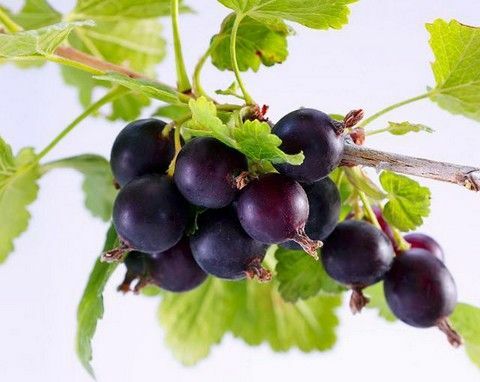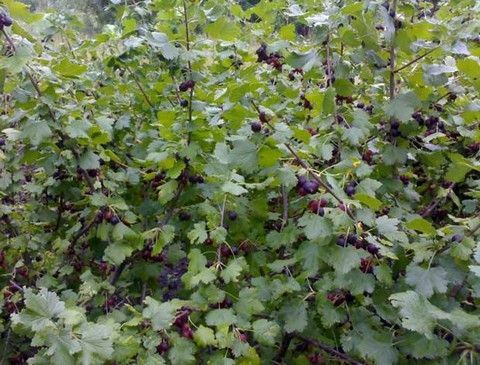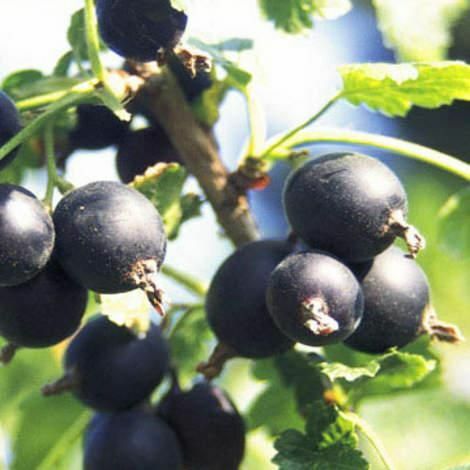A hybrid of currants and gooseberries was bred by the German breeder Rudolf Bauer. This happened not so long ago - in the 1970s. In the process of crossing, three plants participated at once: black currant, gooseberry and gooseberry spread out. The resulting hybrid was named Joshta.

generations have been working on yoshting. Some history
A hybrid of currants and gooseberries, or joshta, is the result of a lot of hard work. The scientists were tasked to increase the yield of black currant and the size of its fruits, as well as make it resistant to diseases such as swallowing and the mites. But at the same time it was necessary to avoid the appearance of thorns, characteristic of gooseberry.
Michurin was the first to start creating a cross-breeding scheme. He developed a theory on which it was possible to cross distant forms of plants - gooseberries and currants. According to his "scenario", breeders from different countries of the world conducted many experiments, but none of them turned out to be successful - all hybrids turned out to be either infertile or non-viable.
Note! Closer than all to a positive result were specialists from Germany, namely, the breeders of the Institute. Max Planck. And their labors soon came to fruition!
After 40 years of hard work in the 1970s, A fruit-bearing hybrid was obtained, and already in 1989 it was ready for use on an industrial scale.
On the territory of the USSR, ioshta was imported in the early 1980s, and it began to be cultivated since 1986.
Note! There are other hybrids of black currant and gooseberries, but they differ dramatically from yoshty in size and taste characteristics of fruits, in the form of shrubs, yields and resistance to winter colds.
Characteristics of the plant
This plant is a perennial berry bushes, quite powerful and sprawling. The bush grows very quickly, throwing out shoots, which in height can reach about one and a half meters. Breeders managed to achieve the absence of spines, so the stems are smooth. As you can see in the photo, a hybrid of currants and gooseberries - joshta - is covered with a dark green crown of large shiny leaves.

The fruiting bush usually has about 15-20 branches, which can vary in length and age. Of these, and consists of a lush crown, in diameter which can reach 2 m.
During the flowering period, the shrubbery is covered with large bright flowers, after which fruits are tied - dark practically black berries with a purple tint. Fruits are collected in small brushes for 4-5 pieces. The skin of the berries is rather dense, and in its form the fruit resembles a cherry. The taste is sweet and sour with a slight muscatel note. It weighs an average of 3 g, but the mass of some can reach 5 g.
During the selection, the following features were achieved:
- pest resistance;
- resistance to certain diseases;
- resistance to winter;
- the life expectancy is from 20 to 30 years.

Cultivation of
To make a hybrid of gooseberry and blackcurrant yield a stable harvest, an open area is needed, which will be well illuminated from all sides. Soil must be loose, sufficiently moistened and rich in organic substances.
The planting time is in spring or early autumn. Top dressing is produced by standard fertilizers for currant and gooseberry. Trimming a bush is not necessary. For the second or third year after planting, you can expect a harvest. From one bush on average, you can collect 7-10 kg of fruit.
Application of
You can use ioshtu in three directions:
- medicine;
- household;
- landscape design.
Traditional medicine
The hybrid of currants and gooseberries contains vitamin C, the amount of which is less compared to currant, but more than 3 times than in gooseberry. In addition, these fruits are rich in anthocyanins and vitamin R.
Yoshida berries are capable of exerting powerful healing properties, and most often they are used:
- in the treatment of diseases of the gastrointestinal tract;
- for improving blood circulation;
- for the removal of salts of heavy metals and radioactive substances from the body.
Important! The selection process included the use of mutagenesis methods, so some ecologists tend to believe that a hybrid of currants and gooseberries is a genetically modified crop. However, in genetic engineering, completely different technologies are used! In addition, this plant has existed for more than a decade, and during this time there has been no recorded case of the occurrence of adverse reactions from the human body - even the usual allergy!
Household
Full ripeness of fruits occurs at the end of July, when they are recommended to be collected. Ripe yoshty berries are characterized by a ratio of acidity and sugars, which is 0.3 higher than gooseberry and 0.8 more than the currant.
To use, the berries of this hybrid are suitable both fresh and after heat treatment. They can be frozen, make from them juices, compotes, jams, jams and so on. In cooking, they are like a black currant.
Recommendation! If you want to make jam from joshta, then it is desirable for him to take half-ripe fruit.
Usage in the
landscape The most common hybrid of gooseberry with black currant plays the role of an ornamental plant. To get a beautiful hedge, bushes are planted at a distance of about 40 cm from each other. If the decorative wall will consist of different plants, then the yoshtu should be planted at a distance of 0.7 to 2 m from other individuals. Since the bush turns out to be rather spreading, single plants should be shaped from time to time.
This is such an unusual joshta, whose closest relatives are the gooseberries and black currants traditional for our latitudes. And this wonder can not only beautify the landscape, but also help in the treatment of certain diseases. Try to plant it on your backyard and you will get a triple benefit!
